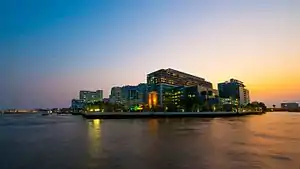Siriraj Hospital
Siriraj Hospital (Thai: โรงพยาบาลศิริราช; RTGS: Rong Phayaban Sirirat) is the oldest and largest hospital in Thailand. It is in Bangkok on the west bank of the Chao Phraya River, opposite Thammasat University's Tha Phrachan campus. It is the primary teaching hospital of the Faculty of Medicine Siriraj Hospital, Mahidol University.
| Siriraj Hospital โรงพยาบาลศิริราช | |
|---|---|
 Siriraj Hospital emblem | |

| |
| Geography | |
| Location | Bangkok, Thailand |
| Organisation | |
| Care system | National Health Insurance System |
| Type | Teaching |
| Affiliated university | Faculty of Medicine Siriraj Hospital, Mahidol University |
| Services | |
| Emergency department | Yes |
| Beds | 2,221 |
| History | |
| Opened | 26 April 1888 |
| Links | |
| Website | www2 |
| Lists | Hospitals in Thailand |
Description
With a capacity of more than 2,000 beds and visited by more than three million patients per year,[1] Siriraj is one of the largest and busiest medical centers[2][3] in Southeast Asia. The medical school accepts about 250 medical students and more than 100 for postgraduate residency training each year. Siriraj is the largest public hospital in Thailand. Thanks to its excellent reputation, its tertiary care unit is the referral center for all hospitals in Thailand.
History

The hospital was founded by King Chulalongkorn in 1888, two years after a worldwide cholera outbreak. It is named after the king's 18-month-old son, Prince Siriraj Kakudhabhand, who had died from dysentery a year before the opening of the hospital. The medical school was established two years later in 1890.
Prince Dipangkorn Rasmijoti were also born here.[4]
Siriraj was the residence of the late King of Thailand, Bhumibol Adulyadej, from September 2009 to August 2013. He entered the hospital for treatment of a respiratory condition. In October 2014 King Bhumibol had gall bladder surgery at Siriraj.[5] He died there on 13 October 2016.[6]

Museums


There are seven medical museums at Siriraj Hospital. They are the Siriraj Bimuksthan Museum, Ellis Pathological Museum, Congdons Anatomical Museum, Songkran Niyomsan Forensic Medicine Museum, Parasitological Museum, Touch Museum in Honor of Queen Mother Sirikit, and Sood Sangvichien Prehistoric Museum Laboratory.[7] The permanent exhibits include sections on anatomy, pathology, congenital disorders, toxicology, techniques of Thai traditional medicine, and forensic pathology. In 2008, the temporary exhibit featured the role of Siriraj Hospital during the 2004 tsunami that devastated the Andaman coastline of Thailand and other countries. The latest museum is Siriraj Bimuksthan Museum, opened in early 2013. The museum is housed in the renovated vintage architecture of the old Bangkok Noi railway station, next to Siriraj's newly opened private subsidiary Siriraj Piyamaharajkarun Hospital. The museum exhibits history of medicine in Thailand from traditional medicine to modern, and includes history of the Bangkok Noi area where the museum and the hospital are situated.
See also
References
- Charoensuthipan, Penchan (21 December 2019). "Refuge for body and soul". Bangkok Post. Retrieved 21 December 2019.
- "Unleashing the Full Potential of Your Medical Travel Program". www.medicaltourismmag.com. Retrieved 2019-05-23.
- "Siriraj Hospital". TakeMeTour. Retrieved 2019-05-23.
- https://www.springnews.co.th/palace/249037
- https://www.bbc.com/news/world-asia-29502108
- https://www.bbc.com/news/world-asia-37643326
- Chaiyong, Suwitcha (17 June 2019). "Grisly guidance". Bangkok Post. Retrieved 18 June 2019.
External links
| Wikimedia Commons has media related to Siriraj Hospital. |
- Faculty of Medicine Siriraj Hospital, Mahidol University Website
- Ramathibodi Hospital Faculty of Medicine, the younger sister medical school of Mahidol University
